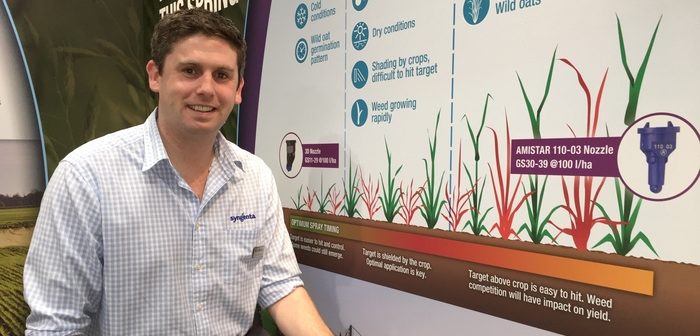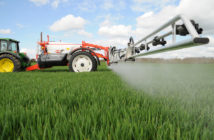Sprayer operators hold the key to better targeting spring grass weed control in growing crops this season – by adjusting pressure and droplet size to hit small weeds more effectively.
Whilst the natural inclination is to increase operating pressure to push sprays down to small weeds at the base of a crop, Syngenta Application Specialist, Harry Fordham, highlights it is bigger droplets at lower pressure that have the momentum to reach the target.
Demonstrating spring grass weed control techniques with Axial Pro at LAMMA 2020 (Birmingham, 7-8 January 2020), Harry pointed out that increasing sprayer pressure actually produces a higher proportion of smaller droplets, which are more easily intercepted and retained in the crop canopy, as well as greater sensitivity to drift.
“The net result is that fewer fine droplets will reach the target small grass weeds, compared to larger droplets produced by nozzles at lower pressure,” he advised. “Application research has shown an operating pressure of 1.5 to 2.5 bar can be the optimum for both the Syngenta 3-D and Amistar nozzles used for spring grass weed control.”
The timing of spring grass weed herbicides poses a particular application challenge for sprayer operators, warns Harry. When crops are still small, at less than GS30, and early emerged grass weeds are exposed, he advocated the Syngenta 3-D nozzle would be the best option to target sprays, providing application conditions are good.
“As crops get larger, through stem elongation stages, and the grass weeds are more shaded under the canopy, however, the angled Amistar nozzle would be a better option to get more droplets down to reach the target.” In trials, 90% drift reduction nozzles, applying 200 l/ha, had also given good results – which could help with spring application opportunities.
Application technique is crucial to enhance herbicide uptake for a complete kill. New application rates for Axial Pro permit up to 0.82 l/ha on larger ryegrass seedlings, over wintered wild oats or more difficult situations, highlighted Harry. The herbicide’s faster uptake is also beneficial if conditions are less conducive to weed growth.
Earlier control of grass weeds is important to reduce effects of competition on the crop, according to Syngenta Technical Manager, Georgina Wood. “That has always been recognised in spring sown crops, but could also be especially important with this season’s slow growing late drilled winter crops,” she added.
The dilemma with application timing for wild oats and ryegrass is when to target the first flush of more competitive early germinating grass weeds, versus the potential for secondary weed flushes. “Later germinating weeds will have less impact on the crop yield, but could still set seed and perpetuate weed problems in subsequent seasons,” warned Georgina.
“The variability of crops and situations this season means decisions for both appropriate Axial Pro rates and application techniques will need to be made on a field-by-field basis.”




